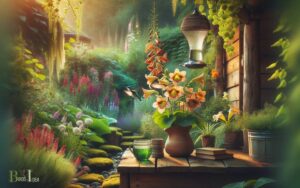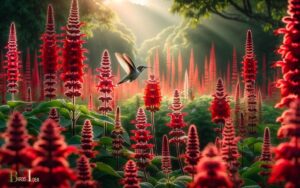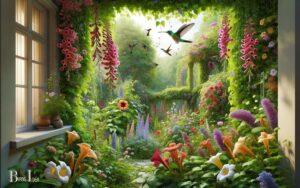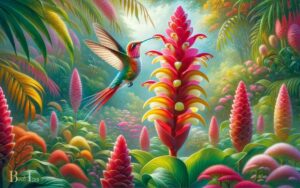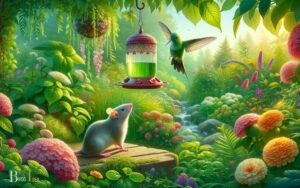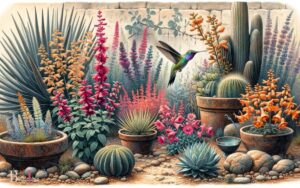Native Plants That Attract Hummingbirds: Red Columbine!
Creating a hummingbird-friendly garden is easy with the right selection of native plants. These plants offer vibrant blooms and the nectar that hummingbirds need for energy.
Some of the best native plants for attracting hummingbirds include red columbine (Aquilegia canadensis), cardinal flower (Lobelia cardinalis), trumpet honeysuckle (Lonicera sempervirens), scarlet beebalm (Monarda didyma), eastern redbud (Cercis canadensis), wild bergamot (Monarda fistulosa), and coral honeysuckle (Lonicera sempervirens).
Incorporating these plants into your garden will not only please the hummingbirds but will also support biodiversity.
Hummingbirds are particularly drawn to certain native plants because of their brightly colored flowers and rich nectar sources.
These plants are adapted to local climates and soil conditions, making them sustainable choices for gardeners.
Here are some characteristics of each:
Enhance your garden’s appeal to hummingbirds with native plants that offer a sustainable and vibrant source of nectar.
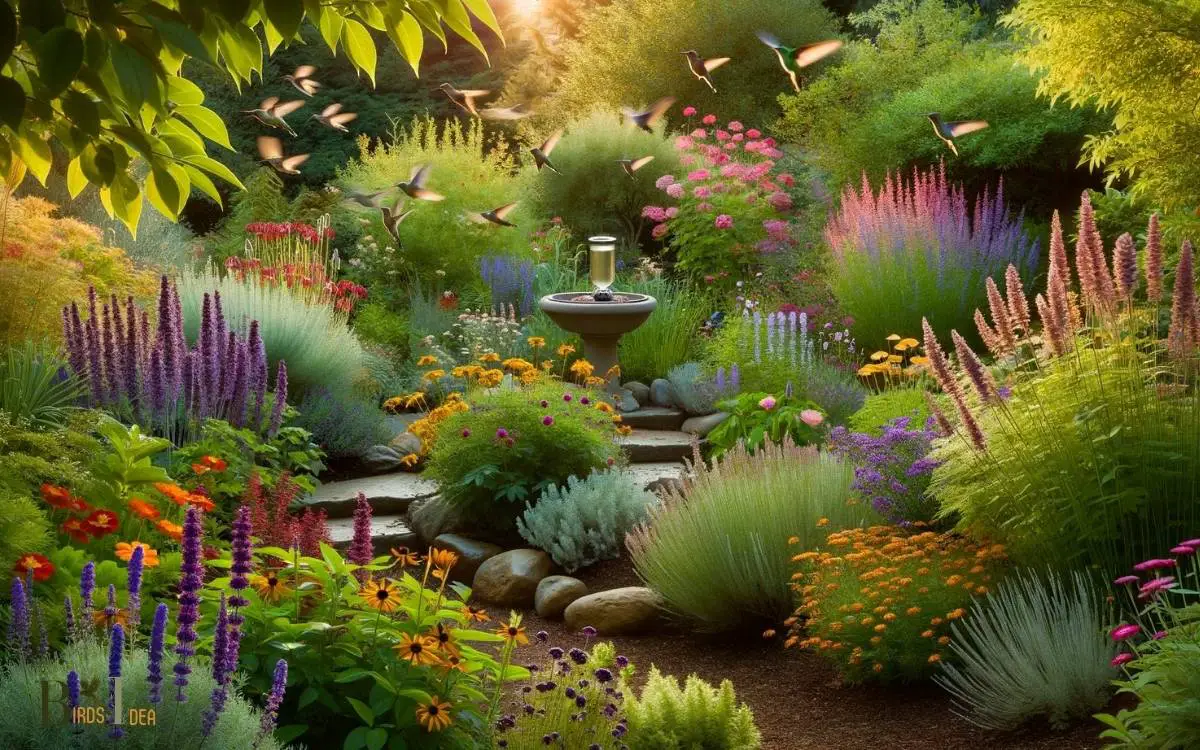
Key Takeaway
7 Native Plants for Hummingbird Gardens
| Common Name | Scientific Name | Flower Color | Bloom Period | Plant Type |
|---|---|---|---|---|
| Red Columbine | Aquilegia canadensis | Red & Yellow | Spring | Perennial |
| Cardinal Flower | Lobelia cardinalis | Red | Late Summer | Perennial |
| Trumpet Honeysuckle | Lonicera sempervirens | Red | Spring to Fall | Vine |
| Scarlet Beebalm | Monarda didyma | Red | Summer | Perennial |
| Eastern Redbud | Cercis canadensis | Pinkish-Purple | Early Spring | Tree |
| Wild Bergamot | Monarda fistulosa | Lavender | Summer | Perennial |
| Coral Honeysuckle | Lonicera sempervirens | Coral | Spring to Fall | Vine |
Importance of Native Plants
One key importance of native plants is their ability to provide essential nectar and habitat for local hummingbird populations. Native plants have co-evolved with native hummingbirds, making them well-suited to provide the necessary resources for these birds to thrive.
These plants offer a diverse array of nectar-producing flowers that are adapted to the specific beak shapes of local hummingbird species, ensuring a reliable food source.
Additionally, native plants serve as nesting sites and offer protection from predators, contributing to the overall health and sustainability of hummingbird populations.
For instance, the red columbine (Aquilegia canadensis) is a native plant known for its tubular, red flowers that are perfectly designed for hummingbird pollination.
Understanding the significance of native plants in supporting local hummingbirds is crucial for promoting biodiversity and ecological balance.
Red Columbine
The Red Columbine (Aquilegia canadensis) is a striking and vibrant perennial plant that produces red and yellow flowers, making it a favorite among hummingbirds.
Its nectar-rich blossoms are perfect for attracting these tiny birds to gardens, providing them with a valuable food source.
Red Columbine is low-maintenance and adaptable, making it an ideal choice for gardeners looking to create a hummingbird-friendly environment without a lot of effort.
Hummingbird-Favorite Red Flowers
Red columbine is a favorite among hummingbirds for its bright red flowers. The tubular shape of the flower is particularly well-suited for the long, slender beaks of hummingbirds, allowing them to easily access the nectar within.
The vibrant red color acts as a beacon for hummingbirds, attracting them from a distance. Additionally, the delicate nature of the red columbine’s blossoms provides a perfect landing pad for these agile birds as they flit from flower to flower.
The nectar produced by the red columbine is rich in sucrose, providing a valuable energy source for hummingbirds.
This combination of visual appeal, accessibility, and nutrient-rich nectar makes the red columbine a highly favored flower among hummingbirds.
- Tubular shape facilitates easy access to nectar.
- Vibrant red color acts as a beacon for hummingbirds.
- Delicate blossoms provide a perfect landing pad for the birds.
- Nectar is rich in sucrose, providing valuable energy.
Ideal for Hummingbird Gardens
Requiring little maintenance, red columbine is a popular choice for hummingbird gardens due to its vibrant red flowers and high nectar yield.
The scientific name for red columbine is Aquilegia canadensis. This perennial plant, native to North America, thrives in partial shade and moist, well-drained soil.
Its distinctive red and yellow flowers bloom from spring to early summer, attracting not only hummingbirds but also bees and butterflies. Red columbine typically grows to a height of 1 to 3 feet and has delicate, lobed foliage.
It is an excellent addition to woodland or wildflower gardens, providing a natural and inviting habitat for hummingbirds.
When planting red columbine, it’s important to ensure proper spacing to allow for adequate air circulation and prevent mildew.
Low-Maintenance Hummingbird Attractor
An ideal low-maintenance hummingbird attractor is the red columbine, known for its vibrant red flowers and high nectar yield.
The red columbine (Aquilegia canadensis) is a perennial wildflower native to North America. Its unique, tubular-shaped flowers are perfectly adapted for the long, slender beaks of hummingbirds.
Here are four reasons why red columbine is an excellent low-maintenance option for attracting hummingbirds:
- Adaptability: Red columbine is adaptable to various soil types and can thrive in both sun and partial shade.
- Low Maintenance: Once established, red columbine requires minimal care, making it an excellent choice for low-maintenance gardens.
- Long Bloom Period: This plant blooms for an extended period, providing a consistent nectar source for hummingbirds.
- Natural Habitat: Red columbine is often found in woodland areas, making it a perfect addition to naturalistic or woodland gardens.
Cardinal Flower
The Cardinal Flower (Lobelia cardinalis) is a striking perennial plant that boasts vibrant red tubular flowers, making it a favorite of hummingbirds.
Its nectar-rich blossoms provide a valuable food source for these agile birds, making it an ideal addition to a garden aiming to attract them.
With its tall, spiky blooms, the Cardinal Flower adds a stunning vertical element to a landscape while also supporting local hummingbird populations.
Cardinal Flower Features
Cardinal flower features vibrant red blooms that attract hummingbirds with their nectar-rich blossoms.
This perennial plant, scientifically known as Lobelia cardinalis, is native to the Americas and is characterized by its striking red tubular flowers.
The cardinal flower possesses several distinctive features that make it an attractive choice for hummingbird gardens:
- Flower Structure: The tubular shape of the cardinal flower’s blossoms is perfectly adapted for the long, slender bills of hummingbirds, allowing them to easily access the nectar.
- Nectar Production: Cardinal flowers produce ample amounts of nectar, which is a vital food source for hummingbirds, sustaining their high energy levels.
- Blooming Period: The cardinal flower typically blooms in late summer, providing a late-season nectar source for hummingbirds as they prepare for migration.
- Attractive Foliage: Apart from its vibrant blooms, the cardinal flower also boasts attractive foliage, enhancing its overall aesthetic appeal in a garden setting.
Hummingbird Favorite Nectar
Boasting vibrant red tubular flowers, the cardinal flower is renowned for attracting hummingbirds with its nectar-rich blossoms.
The nectar of the cardinal flower, Lobelia cardinalis, is a favorite among hummingbirds due to its high sucrose content, making it a valuable food source for these tiny birds.
The rich, sweet nectar of the cardinal flower serves as a high-energy fuel for hummingbirds, providing them with the necessary sustenance for their rapid metabolism and energetic flight patterns.
Hummingbirds are attracted to the cardinal flower’s nectar not only for its nutritional value but also for its accessibility, as the tubular shape of the flower allows for easy access to the nectar with their specialized long, slender bills and tongues.
This unique adaptation makes the cardinal flower a highly sought-after plant for hummingbirds in search of a reliable nectar source.
Ideal Garden Addition
An ideal addition to a garden for attracting hummingbirds is the cardinal flower, which frequently blooms in vibrant red tubular flowers.
The cardinal flower, scientifically known as Lobelia cardinalis, is a native North American perennial plant that belongs to the lobelia family.
Here are some key reasons why the cardinal flower is an excellent choice for attracting hummingbirds:
- Tubular Flowers: The cardinal flower’s tubular shape is perfectly suited for the long, slender bills of hummingbirds.
- Rich Nectar: It produces abundant nectar, providing a valuable food source for hummingbirds.
- Vibrant Color: The bright red flowers are highly attractive to hummingbirds, drawing them to the garden.
- Long Blooming Period: The cardinal flower blooms for an extended period, ensuring a sustained food source for hummingbirds.
Trumpet Honeysuckle
Trumpet Honeysuckle blooms prolifically and attracts hummingbirds with its vibrant red, tubular flowers. Known scientifically as Lonicera sempervirens, this native vine is a favorite of gardeners seeking to create a hummingbird-friendly habitat.
It is a woody, twining vine that can reach heights of 10-15 feet, making it an excellent choice for fences, trellises, or arbors.
The trumpet-shaped flowers are rich in nectar, providing a vital food source for hummingbirds, especially during the summer months.
Trumpet Honeysuckle prefers full to part sun and well-drained soil. Once established, it is relatively low-maintenance, requiring minimal pruning and upkeep.
This plant is an excellent addition to any garden seeking to attract and support hummingbird populations, and its beautiful blooms also add aesthetic value to the landscape.
Scarlet Beebalm
Native to eastern North America, Scarlet Beebalm, also known as Monarda didyma, is a popular choice for attracting hummingbirds to the garden.
This herbaceous perennial plant is characterized by its showy, crimson flowers that bloom from mid to late summer.
Here are some key features of Scarlet Beebalm:
- Habitat: It thrives in moist, well-drained soil and prefers full sun to partial shade.
- Nectar Production: The tubular flowers are rich in nectar, making them highly attractive to hummingbirds and butterflies.
- Growth Habit: Scarlet Beebalm can reach a height of 2-4 feet and has a clump-forming growth habit.
- Maintenance: This low-maintenance plant is relatively resistant to pests and diseases, making it an excellent addition to wildlife gardens and naturalized areas.
Scarlet Beebalm not only adds vibrant color to the landscape but also provides essential nourishment for hummingbirds, making it a valuable plant for wildlife enthusiasts.
Eastern Redbud
The Eastern Redbud is a deciduous tree native to eastern North America and is known for its striking pink or purple flowers that bloom in early spring. Scientifically classified as Cercis canadensis, it belongs to the Fabaceae family.
This small to medium-sized tree typically reaches heights of 20 to 30 feet, with a spread of 15 to 35 feet. Its heart-shaped leaves emerge after the flowers and turn a glossy green as they mature.
The Eastern Redbud thrives in well-drained soils and is often found in woodlands, preferring partial shade but tolerating full sun. It provides nectar for hummingbirds and other pollinators.
The seeds of the Redbud are also consumed by various bird species. This makes it a valuable addition to a garden aiming to attract hummingbirds and other wildlife.
Wild Bergamot
An attractive option for attracting hummingbirds to a garden is the Wild Bergamot, a flowering perennial known scientifically as Monarda fistulosa. This native North American plant offers numerous benefits for both gardeners and hummingbirds.
- Flower Characteristics: The Wild Bergamot produces showy, tubular, pink to lavender flowers that are rich in nectar, attracting hummingbirds with their vibrant color and abundant food source.
- Blooming Period: It blooms from mid-summer to early fall, providing a consistent nectar source for hummingbirds during their active season.
- Growth Habit: This plant can reach heights of 2 to 4 feet, creating a visually appealing addition to any garden or natural area.
- Adaptability: Wild Bergamot can thrive in various soil types and light conditions, making it an adaptable and low-maintenance option for gardeners.
The Wild Bergamot’s attractive qualities make it an excellent choice for attracting hummingbirds.
Coral Honeysuckle
Continuing from the previous discussion of Wild Bergamot, a popular choice for attracting hummingbirds is Coral Honeysuckle, known scientifically as Lonicera sempervirens.
This native vine produces tubular, vibrant red or orange flowers that are rich in nectar, making them irresistible to hummingbirds.
Coral Honeysuckle is a low-maintenance plant that thrives in various soil types and light conditions, although it prefers full sun to partial shade. It blooms from spring to summer and sometimes into fall, providing a long-lasting food source for hummingbirds.
This plant also offers nesting material and shelter for these tiny birds. Gardeners should note that while Coral Honeysuckle is non-invasive, it may require occasional pruning to maintain its desired shape.
Overall, this attractive and beneficial plant is an excellent addition to any garden looking to attract hummingbirds.
Conclusion
Native plants play a crucial role in attracting hummingbirds to gardens and natural landscapes.
Did you know that a single hummingbird can visit over 1,000 flowers in one day, spreading pollen and contributing to the health and diversity of plant species?
By incorporating native plants like red columbine, cardinal flower, and trumpet honeysuckle, gardeners can create a rich and vibrant habitat that supports these beautiful and important pollinators.

